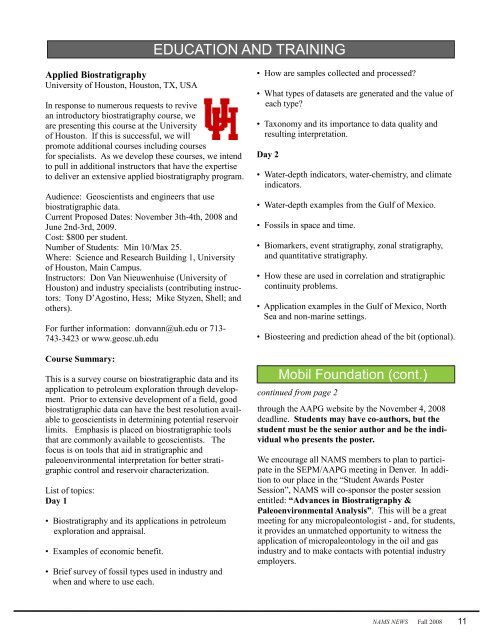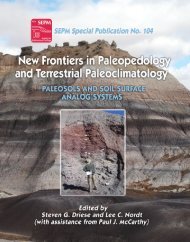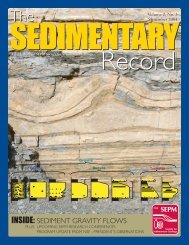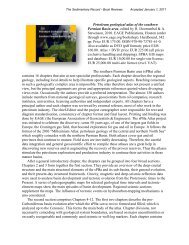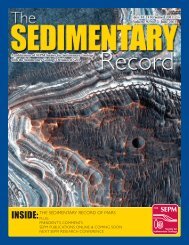Fall 2008 - SEPM
Fall 2008 - SEPM
Fall 2008 - SEPM
You also want an ePaper? Increase the reach of your titles
YUMPU automatically turns print PDFs into web optimized ePapers that Google loves.
Applied Biostratigraphy<br />
University of Houston, Houston, TX, USA<br />
In response to numerous requests to revive<br />
an introductory biostratigraphy course, we<br />
are presenting this course at the University<br />
of Houston. If this is successful, we will<br />
promote additional courses including courses<br />
for specialists. As we develop these courses, we intend<br />
to pull in additional instructors that have the expertise<br />
to deliver an extensive applied biostratigraphy program.<br />
Audience: Geoscientists and engineers that use<br />
biostratigraphic data.<br />
Current Proposed Dates: November 3th-4th, <strong>2008</strong> and<br />
June 2nd-3rd, 2009.<br />
Cost: $800 per student.<br />
Number of Students: Min 10/Max 25.<br />
Where: Science and Research Building 1, University<br />
of Houston, Main Campus.<br />
Instructors: Don Van Nieuwenhuise (University of<br />
Houston) and industry specialists (contributing instructors:<br />
Tony D’Agostino, Hess; Mike Styzen, Shell; and<br />
others).<br />
For further information: donvann@uh.edu or 713-<br />
743-3423 or www.geosc.uh.edu<br />
Course Summary:<br />
This is a survey course on biostratigraphic data and its<br />
application to petroleum exploration through development.<br />
Prior to extensive development of a field, good<br />
biostratigraphic data can have the best resolution available<br />
to geoscientists in determining potential reservoir<br />
limits. Emphasis is placed on biostratigraphic tools<br />
that are commonly available to geoscientists. The<br />
focus is on tools that aid in stratigraphic and<br />
paleoenvironmental interpretation for better stratigraphic<br />
control and reservoir characterization.<br />
List of topics:<br />
Day 1<br />
• Biostratigraphy and its applications in petroleum<br />
exploration and appraisal.<br />
• Examples of economic benefit.<br />
• Brief survey of fossil types used in industry and<br />
when and where to use each.<br />
EDUCATION AND TRAINING<br />
• How are samples collected and processed?<br />
• What types of datasets are generated and the value of<br />
each type?<br />
• Taxonomy and its importance to data quality and<br />
resulting interpretation.<br />
Day 2<br />
• Water-depth indicators, water-chemistry, and climate<br />
indicators.<br />
• Water-depth examples from the Gulf of Mexico.<br />
• Fossils in space and time.<br />
• Biomarkers, event stratigraphy, zonal stratigraphy,<br />
and quantitative stratigraphy.<br />
• How these are used in correlation and stratigraphic<br />
continuity problems.<br />
• Application examples in the Gulf of Mexico, North<br />
Sea and non-marine settings.<br />
• Biosteering and prediction ahead of the bit (optional).<br />
Mobil Foundation (cont.)<br />
continued from page 2<br />
through the AAPG website by the November 4, <strong>2008</strong><br />
deadline. Students may have co-authors, but the<br />
student must be the senior author and be the individual<br />
who presents the poster.<br />
We encourage all NAMS members to plan to participate<br />
in the <strong>SEPM</strong>/AAPG meeting in Denver. In addition<br />
to our place in the “Student Awards Poster<br />
Session”, NAMS will co-sponsor the poster session<br />
entitled: “Advances in Biostratigraphy &<br />
Paleoenvironmental Analysis”. This will be a great<br />
meeting for any micropaleontologist - and, for students,<br />
it provides an unmatched opportunity to witness the<br />
application of micropaleontology in the oil and gas<br />
industry and to make contacts with potential industry<br />
employers.<br />
NAMS NEWS <strong>Fall</strong> <strong>2008</strong><br />
11


